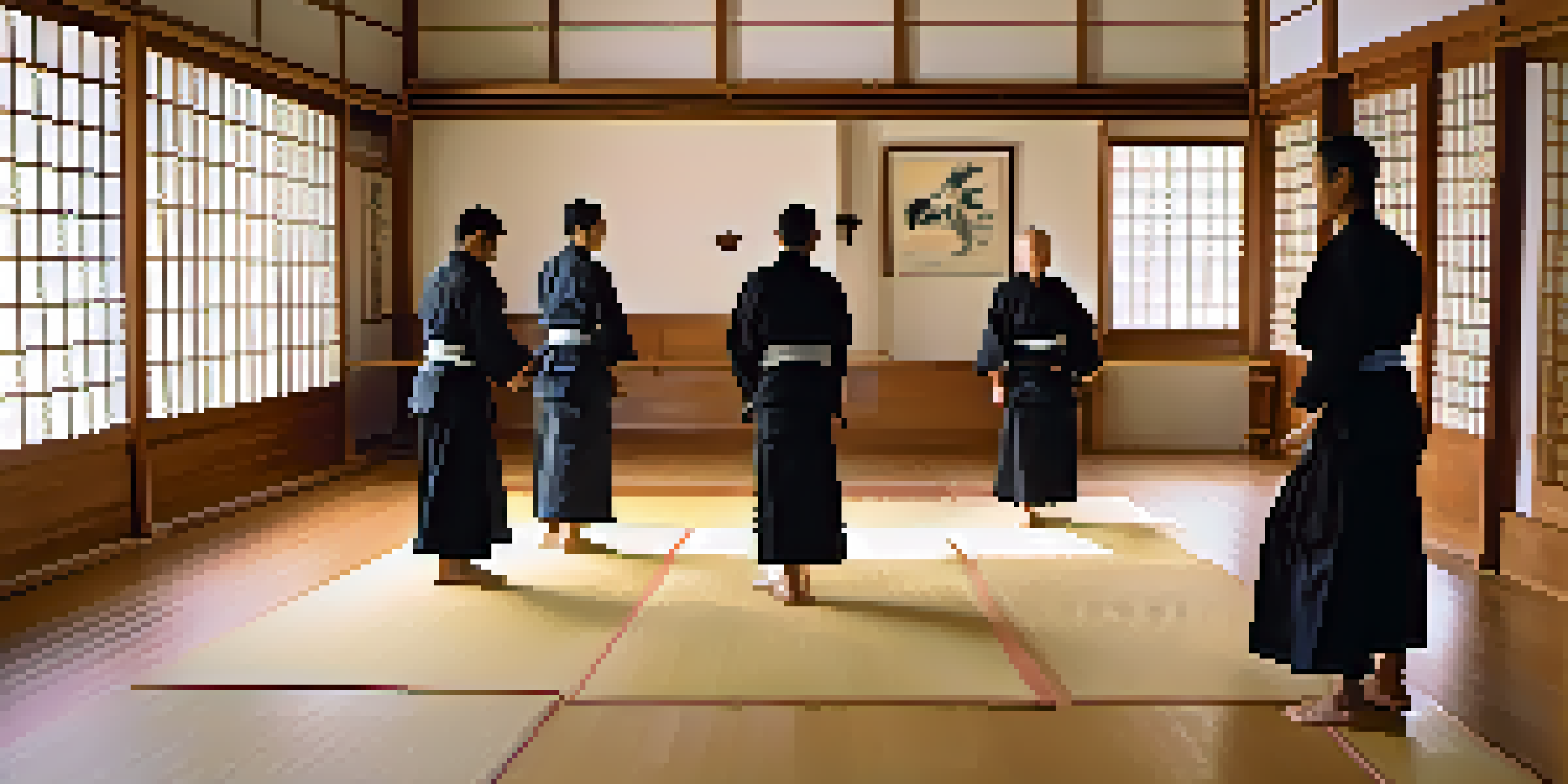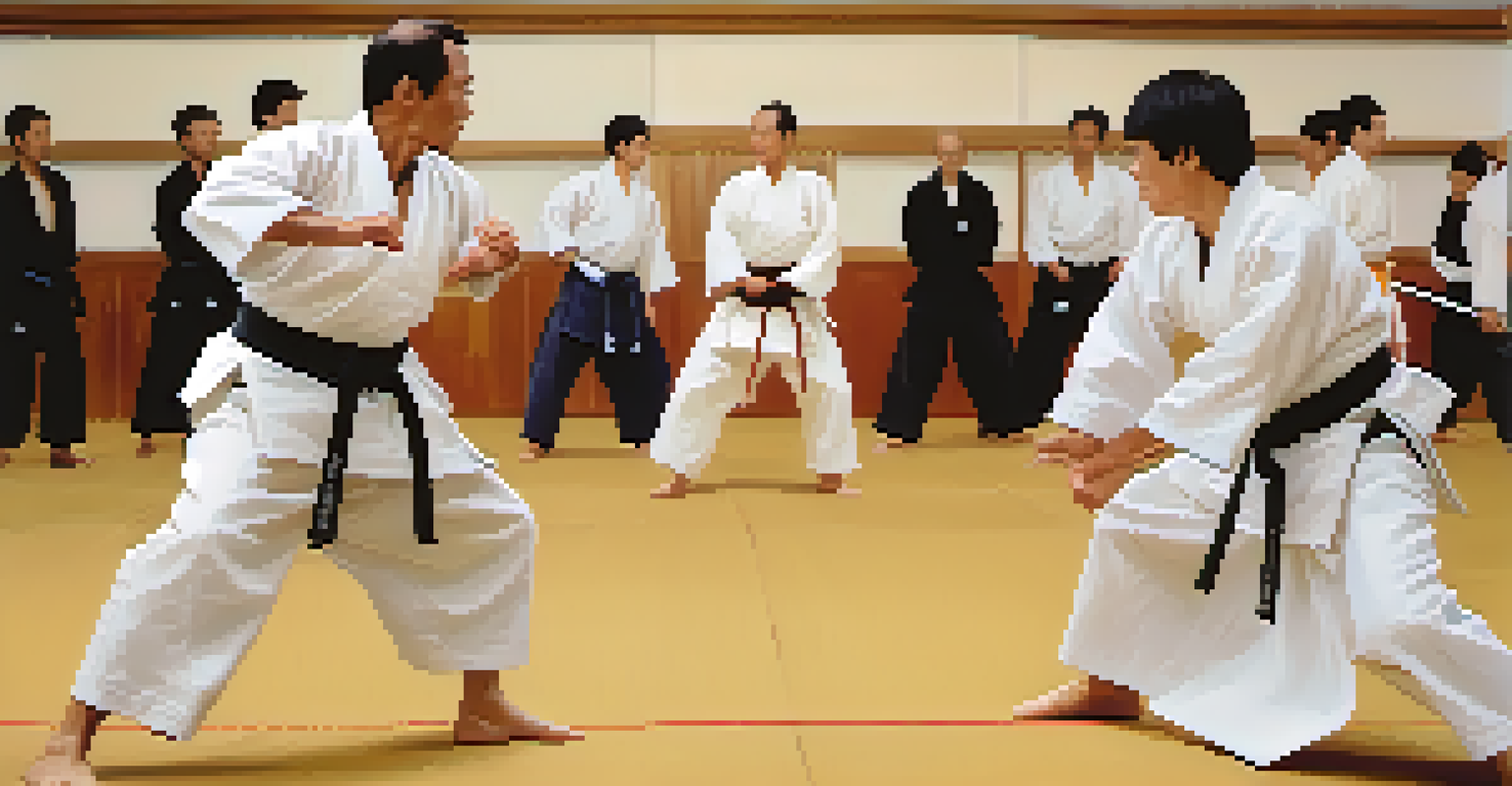The Essence of Aikido: Harmony Between Spirit and Motion

Understanding Aikido: The Art of Peaceful Resolution
Aikido, often translated as 'the way of harmony with spirit,' is a martial art that emphasizes peaceful conflict resolution. Unlike other martial arts that focus on strikes or brute force, Aikido teaches practitioners to redirect an opponent's energy. This unique approach fosters not only physical skill but also mental clarity and emotional balance. By practicing Aikido, individuals learn to remain calm and centered, even in the face of adversity.
The greatest victory is that which requires no battle.
At its core, Aikido is about harmony—not just with others, but also within oneself. This harmony is achieved through the fluid movements that characterize the art. Each technique encourages practitioners to blend with their partner's energy, creating a dance-like interaction rather than an aggressive confrontation. It's a beautiful reminder that strength can be found in gentleness and adaptability.
This philosophy extends beyond the dojo, encouraging practitioners to apply the principles of Aikido in daily life. Whether it's in personal relationships, professional settings, or moments of stress, the lessons learned on the mat can help individuals navigate challenges with grace. Ultimately, Aikido is not just a physical practice; it's a way of life that fosters peace and understanding.
The Philosophy Behind Aikido: Unity of Mind and Body
The philosophy of Aikido is deeply rooted in the concept of unity—specifically, the unity of mind and body. This connection is vital for executing techniques effectively and harmoniously. When practitioners align their physical movements with their mental focus, they achieve a state of flow that enhances both their performance and awareness. This unity is essential not just for martial arts but for overall well-being.

In Aikido, practitioners often engage in meditation and breathing exercises to cultivate this mind-body connection. By fostering awareness and presence, they can react more intuitively and fluidly during practice. This heightened state of consciousness allows for a deeper understanding of oneself and one's surroundings, creating a more profound experience on and off the mat.
Aikido: Harmony in Conflict
Aikido emphasizes peaceful conflict resolution by redirecting energy, promoting both physical skill and emotional balance.
Moreover, this philosophy promotes a sense of inner peace. As individuals learn to harmonize their thoughts and actions, they become more resilient to external pressures. The balance achieved through Aikido practice translates into everyday challenges, empowering practitioners to face life's obstacles with confidence and poise.
Principles of Aikido: Circular Movement and Redirecting Energy
One of the foundational principles of Aikido is the use of circular movements to redirect an opponent's force. Instead of meeting aggression head-on, Aikido teaches practitioners to blend with the attack, using body mechanics and timing to neutralize threats. This technique is akin to a flowing river that bends around rocks, demonstrating adaptability in the face of obstacles.
The mind is everything. What you think you become.
This circular motion is not just a physical technique; it symbolizes the flow of energy in all interactions. By understanding how to redirect energy, practitioners can apply these lessons in various aspects of their lives. Whether dealing with conflict at work or navigating personal relationships, the ability to redirect negativity into positive outcomes is a valuable skill.
Additionally, these principles highlight the importance of intention in Aikido practice. Practitioners are encouraged to approach each interaction with a mindset of peace and harmony. By fostering positive intentions, they create a ripple effect that can transform confrontational situations into opportunities for collaboration and understanding.
Training in Aikido: Building Strength Through Cooperation
Aikido training typically involves practicing techniques with a partner, emphasizing the importance of cooperation. Unlike many martial arts that focus on competition, Aikido nurtures a spirit of mutual support. Both partners work together to learn and improve, fostering a sense of camaraderie that enhances the training experience.
This cooperative training model encourages trust and communication. Practitioners must pay attention to their partner's movements and intentions, creating a dynamic interplay of energy. This level of awareness not only improves technical skills but also deepens relationships, as participants learn to be attuned to one another's needs.
Mind-Body Unity in Aikido
The practice of Aikido fosters a vital connection between mind and body, enhancing awareness and overall well-being.
Moreover, this approach to training cultivates humility. As practitioners recognize that their progress is interconnected with their partner's efforts, they learn to appreciate the journey of growth. This mindset shift from individual achievement to collective improvement fosters a more supportive and enriching training environment.
Aikido's Benefits: Physical, Mental, and Emotional Growth
Practicing Aikido offers numerous benefits that extend beyond the dojo. Physically, it improves flexibility, strength, and coordination. The dynamic movements involved in Aikido encourage practitioners to engage their entire body, leading to better overall fitness. This physical aspect also helps in developing body awareness, which is crucial for injury prevention.
Mentally, Aikido sharpens focus and enhances problem-solving skills. The need to remain present during practice translates into improved concentration in daily tasks. As practitioners learn to navigate challenges with composure, they develop resilience and adaptability—traits that are invaluable in both personal and professional settings.
Emotionally, Aikido fosters a sense of community and belonging. The supportive environment encourages practitioners to share experiences and challenges, creating bonds that go beyond the mat. This emotional support system enhances overall well-being, promoting a positive outlook on life and enriching social connections.
Cultivating Mindfulness: Aikido as a Path to Presence
Mindfulness is a cornerstone of Aikido practice. The art encourages practitioners to cultivate awareness of their thoughts, emotions, and physical sensations. This heightened sense of presence allows individuals to respond to situations with intention rather than react impulsively. It’s like hitting the pause button in a fast-paced world, providing clarity in moments of chaos.
Through techniques like breathing exercises and meditation, Aikido practitioners learn to ground themselves in the present moment. This mindfulness practice extends beyond the dojo, helping individuals approach daily life with a sense of calm and purpose. By staying present, practitioners can better navigate challenges and maintain mental clarity, even during stressful times.
Lifelong Growth Through Aikido
Aikido is a continuous journey of learning and self-discovery, where practitioners develop skills and foster community.
Ultimately, Aikido serves as a powerful reminder of the importance of being present. In a world filled with distractions, the ability to focus on the here and now is a valuable skill. It enriches relationships, enhances decision-making, and fosters a greater appreciation for life’s simple moments.
The Journey of Aikido: Lifelong Learning and Growth
Aikido is often described as a lifelong journey rather than a destination. Each training session offers new lessons and insights, encouraging practitioners to embrace continuous learning. This philosophy instills a growth mindset, where individuals are motivated to explore their potential and refine their skills over time.
As practitioners advance through the ranks, they encounter increasingly complex techniques and concepts. This progression challenges them to expand their understanding of Aikido and themselves. The journey emphasizes that mastery is not solely about achieving a black belt but about the commitment to personal development and self-discovery.

Moreover, the community aspect of Aikido enhances this journey. Practitioners often find mentors and peers who support their growth, creating a network of encouragement and inspiration. This shared experience adds a rich layer to the Aikido journey, fostering connections that last a lifetime while reinforcing the importance of lifelong learning.